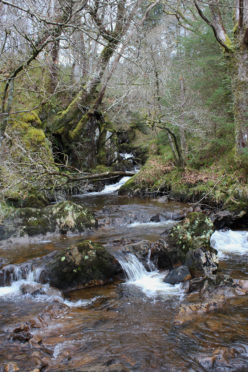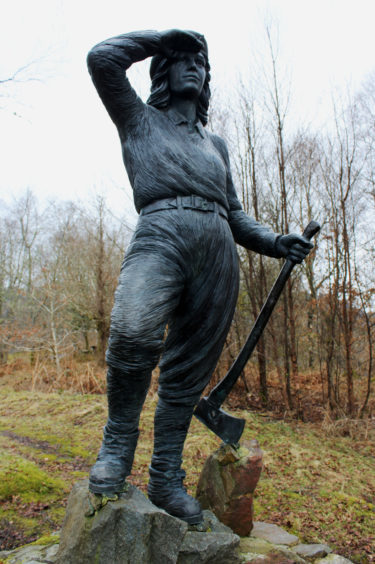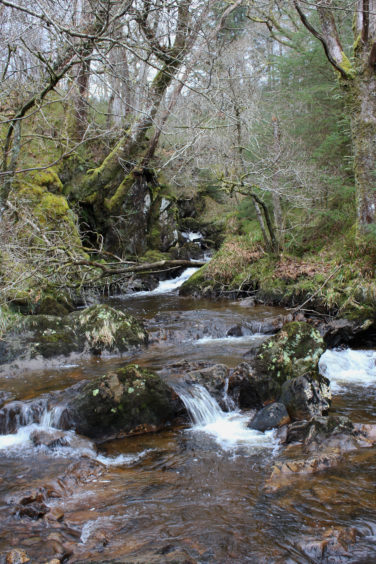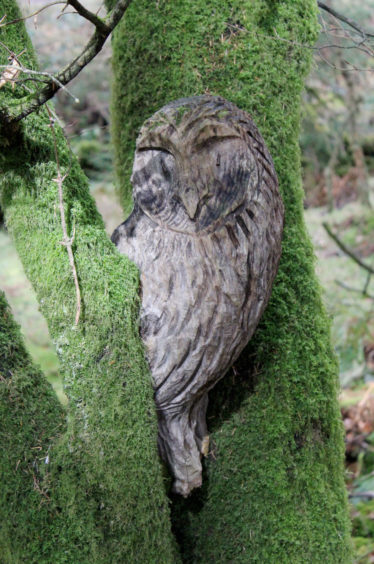Duke’s Pass, Aberfoyle, Stirling.
Formed in April 1942 as an offshoot of the Women’s Land Army, the Women’s Timber Corps worked the forests of Scotland, felling trees, loading lorries and milling wood during the Second World War.
Affectionately known as ‘Lumberjills’, these hard-working women and girls, many in their teens, replaced the foresters who had answered the call to arms.
Every bit as productive as their male counterparts, they maintained a steady supply of timber, including railway sleepers, telegraph poles, mining pit props and ladders, but despite their best efforts received little formal recognition, becoming known as the ‘forgotten corps’.
However, there is a place where their contribution to the war effort is acknowledged and that is at Aberfoyle, deep in the 50,000-acre Queen Elizabeth Forest Park, where a life-sized bronze sculpture of a member of the Women’s Timber Corps gazes out across the wooded landscape.
Close to the Lodge Forest Visitor Centre, a mile north of the Trossachs town, it was my first stop on a loop that not only pays tribute to an overlooked wartime story but also climbs through an historic upland pass.
Various other statues, including a pair of deer and a set of reflective figures, flank the trail as it descends to cross the Allt a’Mhangam below the impressive and rather deceivingly named Little Fawn Falls.
Over the burn, the onward route ascends a forest track, but it is worth making the short detour to the sign-posted red squirrel hide where, thanks to generous feeding (and a little patience), the prospect of spotting one of these timid wee creatures is good. Best times to visit the hide are first thing in the morning or early evening.
The track weaves up past the zip wires and high rope tree-top trails of Go Ape before passing another, smaller waterfall, the viewpoint and its bench a welcome hiatus ahead of the next incline.
The gradient finally eases as the route skirts below the cliffs and crags of Creag Gownan, entering the Duke’s Pass, so called because the Duke of Montrose, who owned the land, commissioned a road through the valley in 1885.
The plantation track, which follows the line of an earlier drove road, runs parallel with the Duke’s road – now the A821 – for a way before meeting up with, and crossing, the bitumen.
Linking Aberfoyle and Loch Katrine, the road was originally built to improve access to the estate but later upgraded to accommodate Victorian tourists drawn to the area by Sir Walter Scott’s poem, ‘The Lady of the Lake’, which extolled the scenic beauty of the loch. It remains a popular scenic drive.
On the other side of the road, a path weaves up through the heather towards a high-level track clearly seen cutting across the hillside. This was laid to service the 19th century slate quarries of Aberfoyle, located in the hills above.
The path peaks just below the track, curving left ahead of a leisurely descent through the valley. Ignore a gravel path branching right on to Craigmore and continue down to meet the road once again.
Back in the woods and accompanied by the sprightly flow of the Allt a’Mhangam, it is an easy and very pleasant stroll down through silver birch, a sheltered place to reflect upon the vital work of the Women’s Timber Corps in these forests over 70 years ago.
ROUTE
1. Join waymarked trail at top of car park, just below visitor centre. Follow path west to statue then loop down and continued east, descending to junction with deer statues.
2. Bear left, following path north past mirror statues, then over boardwalks to junction.
3. Turn right, pass below waterfall and cross bridge over Allt a’Mhangam to meet track. Bear left, ascending track.
4. Turn left and ascend track past Go Ape treetop trail and waterfall viewpoint. Curve right and ascend to crossroads.
5. Turn left and ascend track, swinging left below Creag Gownan. Ignore track branching right and continue to meet A821 beyond gate.
6. Cross road and footbridge and ascend path.
7. Turn left and descend path to A821.
8. Cross road and descend path by Allt a’Mhangam to junction.
9. Turn left to point 3 and retrace steps to visitor centre.
INFORMATION
Distance: 6km/3¾ miles
Ascent: 270m/890ft
Time: 2 hours
Grading: Easy route following waymarked tracks and paths through forestry and across moor with some prolonged sections of ascent. Stout footwear recommended
Start/finish: The Lodge Forest Visitor Centre, a mile north of Aberfoyle on A821 (Grid ref: NN 519015). £3 pay and display parking charge
Map: Ordnance Survey 1:50,000 Landranger sheet 57; Ordnance Survey 1:25,000 Explorer sheet OL46
Tourist Information: Aberfoyle iCentre, Main Street, Aberfoyle FK8 3UQ (Tel 01877 381221)
Public transport: First Bus service C11 links Stirling with Aberfoyle













